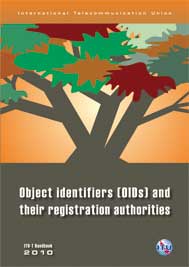 | This Handbook provides information on the use of Object Identifiers (OIDs). It consists of several parts, which will be of interest to different audiences. Part 1 is a general introduction. Part 2 contains historical and background information of a largely tutorial nature. Part 3 provides a full description of the structure of the International OID tree, the high-level arcs and major branches, and the notations and encodings used for expressing OID values. Part 4 is concerned with the practical use of OIDs. It introduces the OID repository and the ITU-T module database. It describes some of the early and current uses of OIDs. Part 5 covers more recent developments, including the International Object Identifier tree, Unicode labels and long arcs. Part 6 discusses the OID Resolution System (ORS) using the Domain Name System (DNS). Part 7 contains instructions on how to obtain an OID for various purposes, and how to manage a sub-authority for allocation of a node to children, including information on actions needed to make use of the ORS.
There are several Annexes (of which the most important are probably those concerned with the setting up and operation of a national registration authority) and a bibliography.Table of contents
|
|